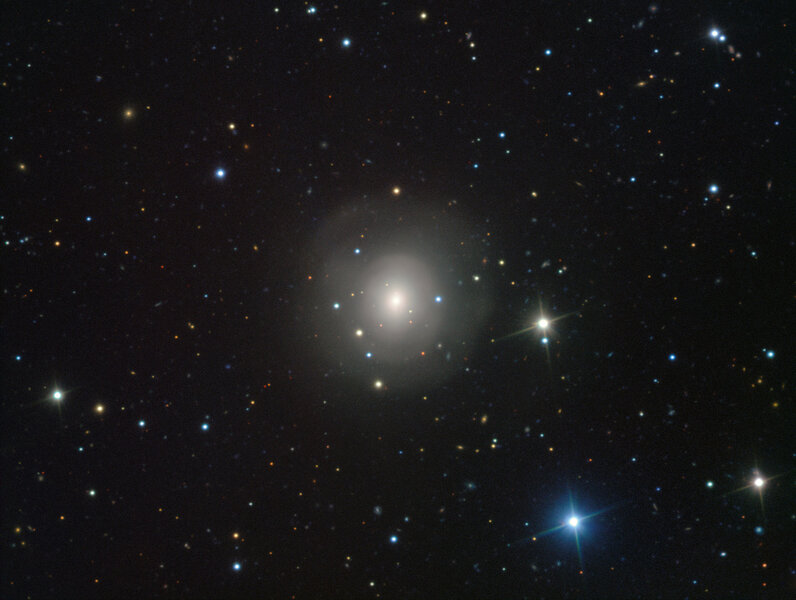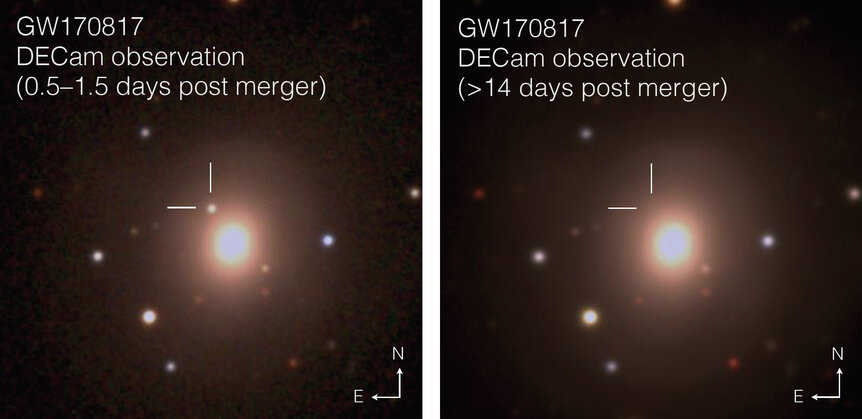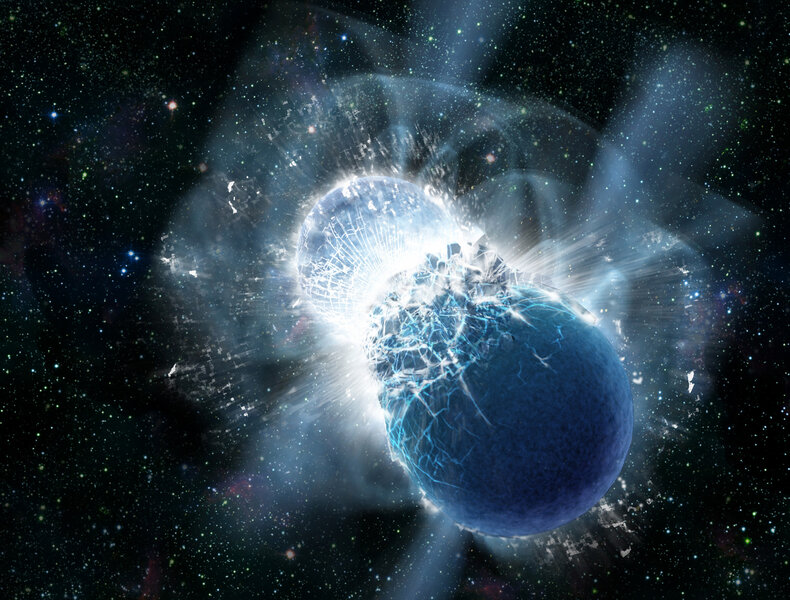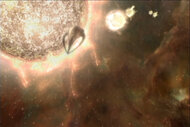Create a free profile to get unlimited access to exclusive videos, sweepstakes, and more!
BIG NEWS: For the first time, astronomers detect gravitational waves from two neutron stars crashing together!
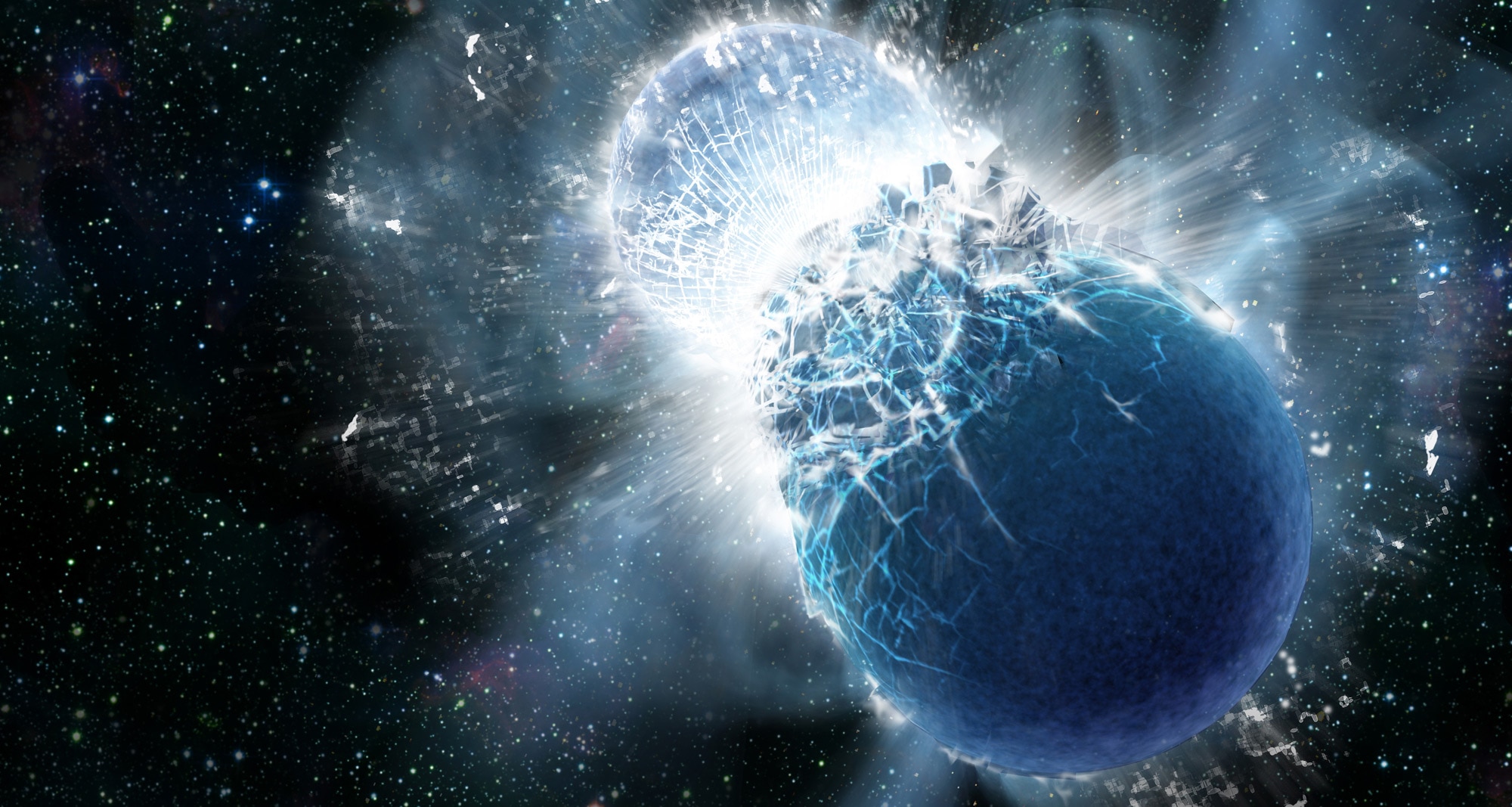
Long, long ago, a pair of neutron stars were on the brink of a cataclysm.
Formed from massive stars billions of years earlier, these two supremely dense objects had been dancing around each other since the Universe was young. As they did, they slowly leaked away energy in the form of gravitational waves, ripples in the very fabric of space and time. Slowly, oh so slowly, they edged closer, revolving faster bit by bit as their mutual orbit cinched tighter.
The waves they emitted were a whisper at first, barely affecting space around them. But, over the eons, the whisper grew, until the loss of energy was too much. In the final few milliseconds, whirling around each other at a substantial fraction of the speed of light, the whisper of gravitational waves turned into a shout, then a roar.
At that moment, the mutual and ferocious gravity of the two neutron stars grew overwhelming: They literally ripped each other apart. At the center of the maelstrom the gravity was so intense the material crashed inward, and the gravitational waves emitted reached a fever pitch. The material was under such force that they tore a hole in space and time: A black hole was born ... and the shriek of gravitational waves was its birth cry.
As that chaos around the newly formed black hole began to organize itself, a phenomenally complex witch’s brew of forces also focused twin blasts of energy up and down from the chaos, huge pulses of light that screamed away into the blackness of space.
The ripples in space from the gravitational waves moved outward, followed closely behind by the fierce beams of light. They traveled for 130 million years before reaching Earth. Dimmed by the length of their journey, the waves passed through our planet, stretching it ever so slightly. A mere two seconds later the light from the catastrophe descended on our planet as well.
The flashes of energy from the neutron star merger, sent across the Universe before T. rex strode the Earth, reached the instruments of astronomers on and above the Earth ... and signaled not just the birth of a black hole, but also of a new kind of astronomy.
As you might expect, this is very big news. Astronomers have been waiting a very long time to see exactly this sort of event.
If you’ve been paying attention to astronomy news, you may know that four gravitational wave events have been positively detected by the Laser Interferometry Gravitational Wave Observatory, or LIGO. These are caused by the mergers of two enormous black holes; as they spiral in together, they shake the space-time continuum, creating ripples in it that expand away a bit like waves on a pond when you toss a heavy rock in. These literally stretch and compress space, but by the time these waves reach us, they are extremely low amplitude and take incredibly precise measurements to see. LIGO is designed to detect them.
The first such event was detected in 2015. Three more have been seen, the last one in August 2017 when LIGO was joined by another facility, Virgo, in Europe. Together, their sensitivity was increased, allowing them to detect even fainter gravitational waves.
The hope for quite some time has been that these enhanced observatories would be able to detect neutron star mergers as well, which are lower-energy than black hole collisions, and therefore more difficult to detect.
That hope became reality at 12:41 UTC on August 17, 2017 (just three days after the last black hole detection). A faint signal was received at the detectors at that moment, matching the profile of a neutron star/neutron star collision. The astronomers dubbed it GW170817: a gravitational wave event seen on 2017 August 17. It was the first time the gravitational waves from such an event had ever been detected!
But what makes this even more exciting is that the Fermi gamma-ray telescope orbiting high above the Earth also detected a weak flash of gamma rays just two seconds later. Fermi has instruments on it designed to look for gamma-ray bursts (GRBs), the soul-crushingly powerful explosions emitted when black holes are born. Gamma rays are the highest-energy form of light, sent out in a fierce blast at the formation moment of a new black hole, and we’ve been detecting them from exploding stars and merging neutrons stars for decades now. The burst just seen, GRB 120817A, is one of hundreds already seen, and in fact a rather weak one at that.
But the faintness of the burst belies the extraordinary nature of the event: This is the very first time a GRB has been detected along with the gravitational waves from the black hole formation!
This is incredibly important. The direction to the source of gravitational waves is extremely hard to pin down using LIGO/Virgo, but Fermi’s detection of the gamma rays narrowed the location in the sky with far higher precision.
And that’s where this gets better still: Astronomers around the world were immediately notified, and within hours they were scrambling to search the targeted spot in the sky. Images taken using the Henrietta Swopes 1-meter telescope at the Las Campanas Observatory in Chile were compared to ones taken earlier of the same region, and after looking at only nine images they hit paydirt: A new point of light located very near the center of the galaxy NGC 4993, an old but luminous galaxy 130 million light-years away.
That unassuming dot had vast import. For the first time, astronomers had found the visible afterglow of a neutron star merger that had also been detected by gravitational waves.
As an astronomer I can tell you that the nature of this is nothing short of a breakthrough. With the afterglow detected, a huge amount of data becomes available. The distance to the galaxy means we know how much energy was emitted. The rate at which it faded proved it not just a typical supernova, an exploding star; those fade over weeks and months, where this one dropped like a rock in mere days.
The material blasted outward from the explosion could be examined. It consists of two components, one thinly spread and moving very rapidly — fully a third the speed of light! — and a thicker, slower one, moving outward at a more leisurely, but still staggering, 1/10th light speed.
As more telescopes observed the event, more was learned. Radio waves and X-rays emitted showed that the beams of matter and energy emitted by the explosion were aimed slightly away from us, probably by about 30°. As that material slammed into matter inside the host galaxy it slowed and puffed outward; the beams widened, spreading their aim, and we on Earth so very far away caught the edges of them. That’s why the gamma-ray burst was faint, even though this object was very close by in a cosmic sense relative to most GRBs; we only saw the edge of the blast. The energy received was only about a thousandth as bright as other GRBs like it elsewhere; had the beams been aimed directly at us this would have been a phenomenally bright event (to be clear, I mean bright to an astronomer; it still would’ve taken a telescope to detect it).
And this gets better yet. Astronomers took spectra of the afterglow, breaking the light up into individual colors. This allows a lot of information to be gleaned about the source. What they found is that the way the material glowed and faded was consistent with the creation of what we call r-process elements: The explosion was so powerful that lighter elements were able to rapidly capture neutrons ricocheting around inside the blast wave, performing stellar alchemy and changing their atomic structure into heavier elements. Which elements? Ones like gold and platinum.
Are you wearing gold jewelry? Probably some of the parts of the computer on which you’re reading this article use gold and/or platinum to operate. Until now, we weren’t exactly sure how those elements were created in the Universe; it was thought they were formed in normal supernova explosions, but the physics was saying they must be created somewhere else. Now we know where.
Do you see? These elements were created in the heart of the catastrophic merger of two massive neutron stars billions of years ago somewhere in our own galaxy, a tremendous but brief explosion that left behind a black hole and scattered those precious elements into space. They seeded a cloud of gas and dust, which itself collapsed to form the Sun, the planets ... and Earth. 4.56 billion years later, we mined those materials from our planet, admired them, used them to adorn ourselves, and created machines that allowed us to understand how those elements formed in the first place.
The Universe has created the conditions in which it can study itself. That’s what this newest burst means.
Some people ask me why I love astronomy so much. I find this question amusing. How can you not?
